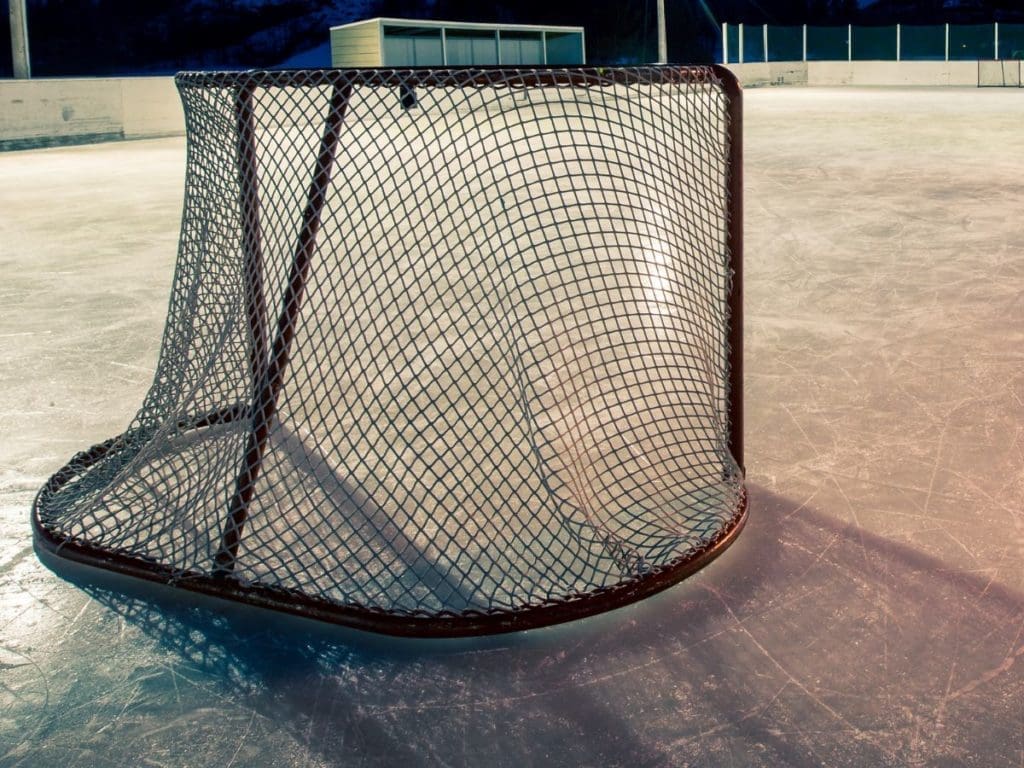NHL Nets Size
The official hockey nets used in NHL games have specific dimensions, commonly referred to as NHL dimensions or NHL standard size. The official goal frame is six feet wide (or 1.83 meters) and four feet high, which goes up to the square crossbar or top corners of the net. It has a depth of 44 inches (or 1.12 meters).


A vital part of this exciting game is the hockey goal. If you’ve ever wondered about the dimensions of a hockey net or the official size of an NHL net, you’re in the right place. We’ll cover everything from the goal frame and opening of the goal to aspects like the base depth of the net.
Jump to a section:
The Anatomy of A Hockey Net
Typically, a hockey net consists of a few crucial parts, like vertical posts, a horizontal crossbar, and a net protector to aid in competitive play. Most hockey nets also include a top shelf, essentially a horizontal bar at the top of the net. This shelf prevents the puck from bouncing out after a high shot.
Let’s delve into the nitty-gritty of the dimensions of a hockey net and its components.
Vertical Posts and Horizontal Crossbars
The goalposts are the vertical side posts of the goal, while the crossbar is the horizontal bar at the top of the goal frame. According to NHL standards, these posts should be red. Inferior construction can lead to poor play quality; hence the posts are usually made up of a durable metal tube frame to provide extreme durability.
Read More: What Is A Point In Hockey?
Base Depth
Another essential consideration in the dimensions of a hockey net includes its depth. This dimension refers to the base depth of a net, or in other words, the footprint of the goal. This measurement refers to the distance from the goal line towards the back of the net.
A Deeper Dive Into Base Depth
The base depth of a hockey net is more than just a measurement – in fact, it plays a vital role in the game. This measurement holds specific significance in the game of hockey and can impact the gameplay in different ways.
The Role of Base Depth
Base depth contributes to the game’s dynamics by affecting the puck’s movement and consequently, the strategies adopted by the goalkeepers and players. A deeper net allows for more space behind the net, providing an additional area for players to maneuver and set up plays. The area behind the net, often referred to as Gretzky’s office—named after the legendary player Wayne Gretzky who famously utilized this space—can be a vital strategic square for experienced players.
The Standards of Base Depth
The standard base depth or the footprint of an ice hockey goal as specified by the NHL rules is 44 inches, around 1.11 meters. Essentially, if you dropped a plumb bob from the middle of the crossbar to the ice, the distance between this point and the exterior of the goalpost should be about 44 inches. This depth creates an additional tactical dimension in the game by providing a ‘zone’ for the puck to go to, giving players the chance to reposition.
The Impact of Base Depth
A net with a smaller base depth leaves less room for the puck to go, and players have to quickly gain control and steer the puck towards the goal. A more profound net, coupled with the puck’s speed, could potentially lead to more missed shots, making it more challenging for the goalie.
Variations in Base Depth
While the standard base depth of an NHL net is 44 inches, other types of hockey, such as street hockey or mini hockey, can have different net dimensions, including varying base depths. These differences might be to accommodate the setting (street vs. ice) or the skill level (children vs. adults).
Hockey Net Material
A high-quality net needs to withstand high-intensity play, and therefore, nets are often made up of durable materials. Most are often made up of high-quality nylon or knotless nylon – this mesh net design allows the net to catch and hold ice hockey pucks, hockey balls and even large stones if it comes to street hockey.
Has The NHL Ever Changed The Net Size?
As of now, the NHL has not changed the regulation goal size and has not in many decades. The specifications of a regulation size hockey goal remain: 4 feet high, 6 feet wide, with a depth of 44 inches.
Youth Hockey and Different Dimensions
Apart from the official NHL dimensions, there are different dimensions for mini target goals utilized in youth hockey and mini hockey games to accommodate players’ technical skills according to their age. These can start as small as 36 inches in width for the youngest players and increase as per the age bracket.
Conclusion
Whether you are a professional athlete or a hockey enthusiast looking for knowledge of the game, an understanding of the dimensions of a hockey net will undoubtedly enhance your gaming experience. Equipped with a newfound understanding of goal frames, goals posts, net materials, NHL standards, ice hockey goals, and even the changes (or lack thereof!) in goal sizes, you’re now ready to bring your A-game to the ice as an informed player.
Read More: What Is A Slewfoot In Hockey?



